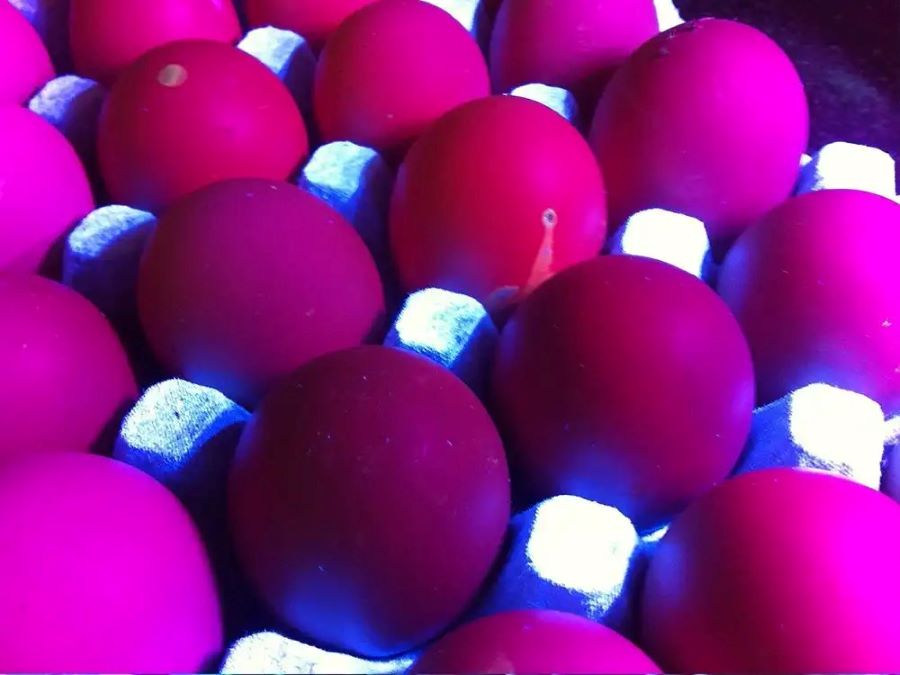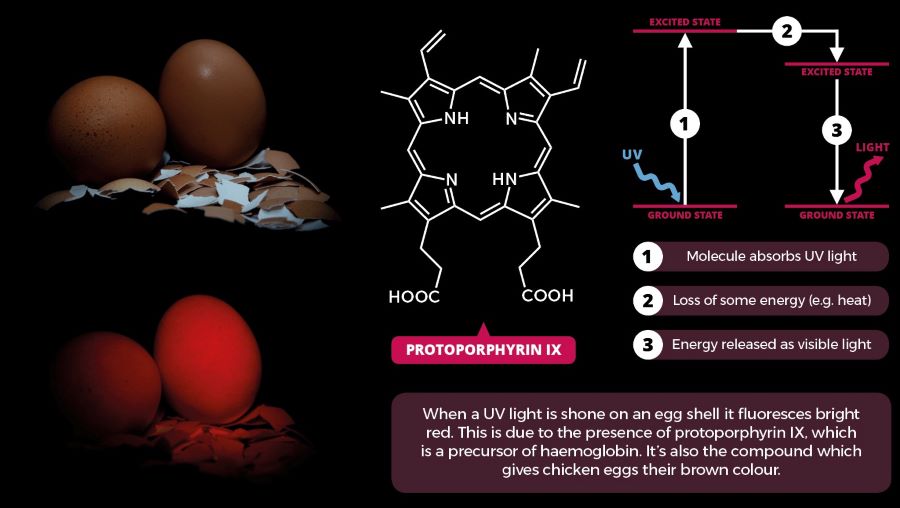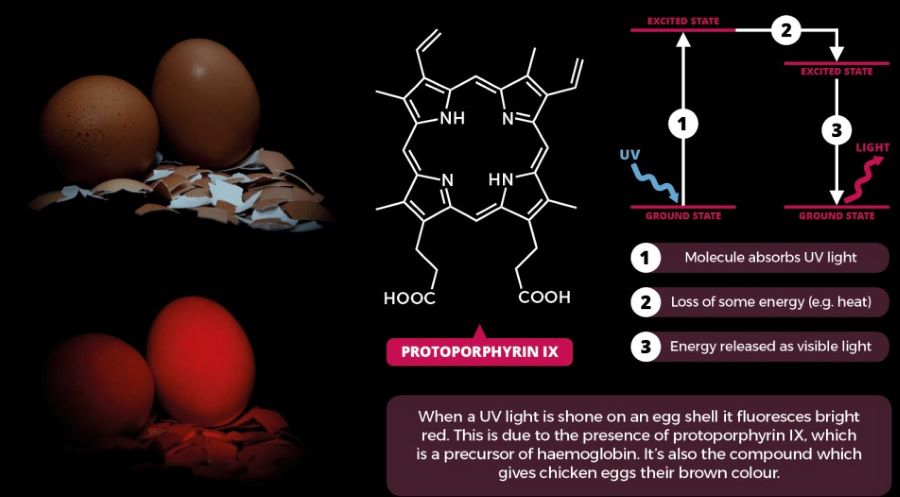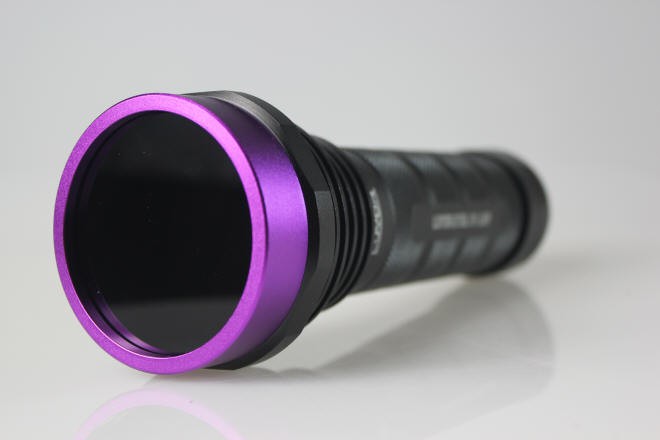一套荧光检漏套装解决工业设备泄漏
LUYOR-6801荧光检漏仪是美国路阳公司生产的荧光检漏仪套装,适用于检查小到中等规模的油基液体系...
2024-03-28作者:luyor时间:2020-06-18 22:31浏览14189 次
紫外线下鸡蛋的红色发光或荧光是由于在蛋壳中发现的特定分子引起的。该分子是原卟啉IX(PPIX)。PPIX是血红蛋白的前体,是使我们的血液(和鸡的血液)呈现红色的色素。那么,该分子如何进入蛋壳?
用紫外线灯照射鸡蛋上。蛋壳会发出红色光芒。是什么导致这种红色发光?这就是该图形的外观!
紫外线下鸡蛋的红色发光或荧光是由于在蛋壳中发现的特定分子引起的。该分子是原卟啉IX(PPIX)。PPIX是血红蛋白的前体,是使我们的血液(和鸡的血液)呈现红色的色素。那么,该分子如何进入蛋壳?

PPIX通过特定酶的作用转化为血红蛋白的非蛋白质成分血红素。在包括鸡在内的某些鸟类的输卵管中,该酶的活性较低。至于这样做的结果,PPIX 被合并到蛋壳,赐给他们的棕褐色。
PPIX使蛋壳在紫外线下发出荧光。荧光是由于PPIX分子中的电子吸收了紫外线。这将电子推向短暂的更高能量的“激发态”。首先,一些多余的能量例如作为热量损失到周围环境中。然后,电子回落到它们的原始能级,从而消除了多余的能量,即可见光。这被视为荧光。从开始到结束,整个过程超过了十亿分之一秒。
这里对荧光的过程有更详细的解释。下图显示了PPIX二甲基酯的荧光(之所以使用,是因为它具有更好的溶解性和稳定性)。下面的图像(以及主图中的图像)由Hannes Hiller提供,后者在MicroXtals 分享了漂亮的化学图像。

鸡蛋荧光化学pt 2
注意:使用紫外线灯重现本文中图片中看到的荧光应该没有问题。请注意,如果要在实验室中重现效果,则实验室中使用的常规UV-A光源为365 nm –该波长不足,因为PPIX在该波长附近几乎没有吸收。因此,重要的是要使用“廉价”的紫外光源(395至405 nm)来再现结果!
鸡蛋检查
紫外线检查灯用于散养鸡蛋的质量控制检查,以检测是否有清洗或擦拭的迹象,并突出显示细菌和霉菌造成的腐败。目前已被DEFRA鸡蛋检验员,孵化场,鸡蛋包装中心,批发商和食品加工商使用。
Egg Inspection
UV inspection lamps are used for quality control inspection of free-range eggs to detect evidence of washing or wiping and highlighting spoilage by bacteria and mold. Currently used by DEFRA egg inspectors, hatcheries, egg packing centers, wholesalers and food processors.

Here’s something to try over the Easter weekend: take a UV light and shine it on some eggs. You’ll be rewarded with a red glow from their shells. What causes this red glow? That’s what this graphic looks at!
The red glow, or fluorescence, of eggs under a UV light is due to a particular molecule found in egg shells. This molecule is protoporphyrin IX (PPIX). PPIX is a precursor of haemoglobin, the pigment that gives our blood (and that of chickens) its red colour. How, then, does this molecule get on to eggshells?
PPIX converts into haem, the non-protein component of haemoglobin, by the action of a particular enzyme. This enzyme’s activity is low in the oviduct of some birds, including chickens. As a consequence of this, PPIX is incorporated into egg shells, given them their brown colour.
PPIX causes egg shells to fluoresce under UV light. The fluorescence is due to electrons in PPIX molecules absorbing the UV light. This pushes the electrons to a higher energy ‘excited state’, which is short-lived. First, some of the excess energy is lost to the surroundings, for example as heat. Then, the electrons fall back to their original energy level, getting rid of their excess energy as visible light. This is seen as fluorescence. From start to finish, the whole process is over in billionths of a second.
There’s a more detailed explanation of the process of fluorescence here. The image below shows the fluorescence of the dimethyl ester of PPIX (used because it has better solubility and stability). The images below (and those in the main graphic) were kindly provided by Hannes Hiller, who shares beautiful chemistry images over at MicroXtals.
Note: You should have no problem with using UV torches to reproduce the fluorescence seen in the pictures in this post. Note that if you’re trying to reproduce the effect in a laboratory, the normal UV-A light source used in labs is 365 nm – this wavelength is insufficient because PPIX has almost no absorption around this wavelength. So it’s important to use the “cheap” UV sources (395 to 405 nm) to reproduce the results!

用于检查鸡蛋质量的紫外线手电筒LUYOR-2130L